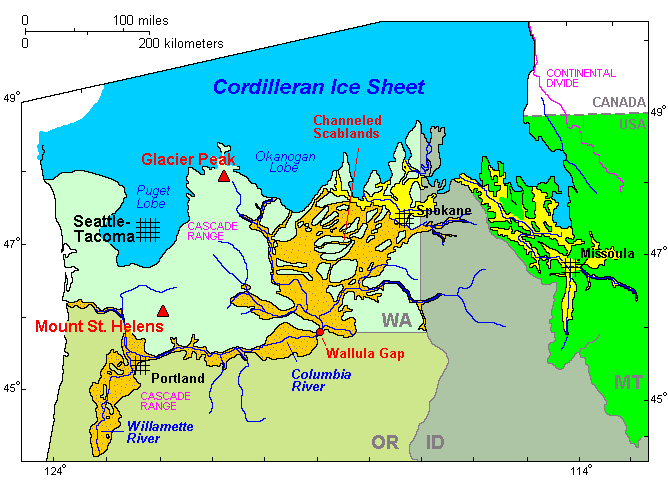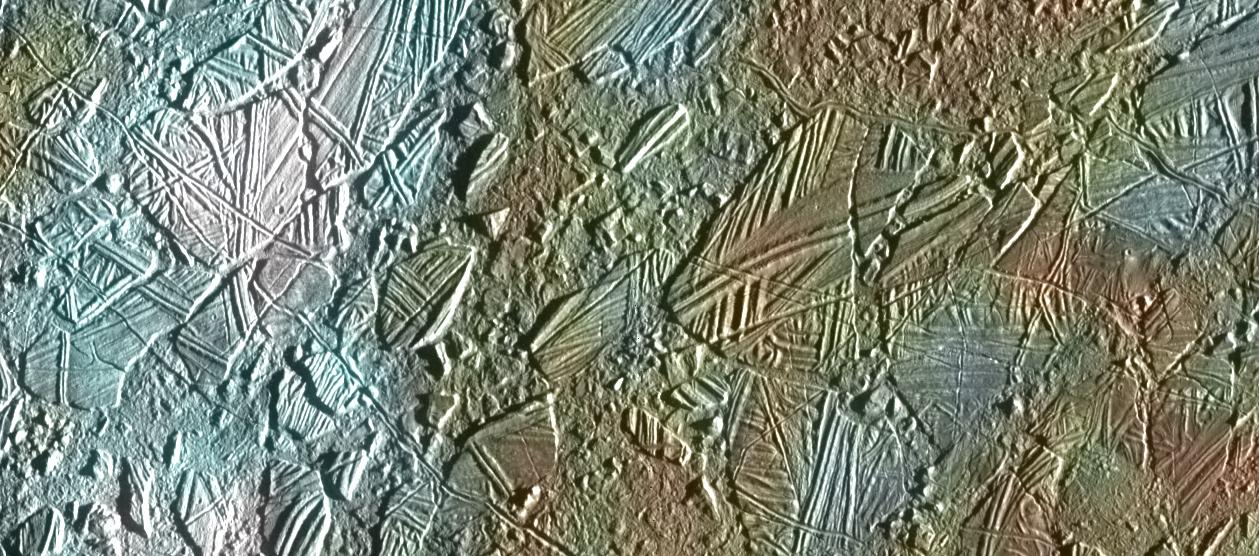|
Hydaspis Chaos
Hydaspis Chaos is a region in the Oxia Palus quadrangle of Mars, located at 3.2° north latitude and 27.1° west longitude. The region is about 355 km across. It was named after a classical albedo feature. River Valleys and Chaos Many large, ancient river valleys are found in this area; along with collapsed features, called Chaos. The Chaotic features may have collapsed when water came out of the surface. Some of the rivers begin with a Chaos region. A chaotic region can be recognized by a rat's nest of mesas, buttes, and hills, chopped through with valleys which in places look almost patterned. Some parts of this chaotic area have not collapsed completely—they are still formed into large mesas, so they may still contain water ice. Chaotic terrain occurs in numerous locations on Mars, and always gives the strong impression that something abruptly disturbed the ground. The chaos regions formed long ago. By counting craters (more craters in any given area means an older ... [...More Info...] [...Related Items...] OR: [Wikipedia] [Google] [Baidu] |
Oxia Palus Quadrangle
The Oxia Palus quadrangle is one of a series of 30 quadrangle maps of Mars used by the United States Geological Survey (USGS) Astrogeology Research Program. The Oxia Palus quadrangle is also referred to as MC-11 (Mars Chart-11). The quadrangle covers the region of 0° to 45° west longitude and 0° to 30° north latitude on Mars. This quadrangle contains parts of many regions: Chryse Planitia, Arabia Terra, Xanthe Terra, Margaritifer Terra, Meridiani Planum and Oxia Planum. Mars Pathfinder landed in the Oxia Palus quadrangle at , on July 4, 1997, at the intersection Tiu Valles and Ares Vallis. Many craters within Oxia Palus are named after famous scientists. Besides Galilei and da Vinci, some of the people who discovered the atom and radiation are honored there: Curie, Becquerel, and Rutherford. Mawrth Vallis was strongly considered as a landing site for NASA's ''Curiosity'' rover, the Mars Science Laboratory. It made it to at least the top two sites for NASA's EXoMars 20 ... [...More Info...] [...Related Items...] OR: [Wikipedia] [Google] [Baidu] |
Channeled Scabland
The Channeled Scablands are a relatively barren and soil-free region of interconnected relict and dry flood channels, coulees and cataracts eroded into Palouse loess and the typically flat-lying basalt flows that remain after cataclysmic floods within the southeastern part of Washington.Neuendorf, K.K.E., J.P. Mehl, Jr., and J.A. Jackson, eds. (2005) ''Glossary of Geology'' (5th ed.). Alexandria, Virginia, American Geological Institute. 779 pp. The Channeled Scablands were scoured by more than 40 cataclysmic floods during the Last Glacial Maximum and innumerable older cataclysmic floods over the last two million years. These floods were periodically unleashed whenever a large glacial lake broke through its ice dam and swept across eastern Washington and down the Columbia River Plateau during the Pleistocene epoch. The last of the cataclysmic floods occurred between 18,200 and 14,000 years ago.Balbas, A.M., Barth, A.M., Clark, P.U., Clark, J., Caffee, M., O'Connor, J., Baker, V ... [...More Info...] [...Related Items...] OR: [Wikipedia] [Google] [Baidu] |
Washington (state)
Washington (), officially the State of Washington, is a state in the Pacific Northwest region of the Western United States. Named for George Washington—the first U.S. president—the state was formed from the western part of the Washington Territory, which was ceded by the British Empire in 1846, by the Oregon Treaty in the settlement of the Oregon boundary dispute. The state is bordered on the west by the Pacific Ocean, Oregon to the south, Idaho to the east, and the Canadian province of British Columbia to the north. It was admitted to the Union as the 42nd state in 1889. Olympia is the state capital; the state's largest city is Seattle. Washington is often referred to as Washington state to distinguish it from the nation's capital, Washington, D.C. Washington is the 18th-largest state, with an area of , and the 13th-most populous state, with more than 7.7 million people. The majority of Washington's residents live in the Seattle metropolitan area, the center of trans ... [...More Info...] [...Related Items...] OR: [Wikipedia] [Google] [Baidu] |
Pleistocene
The Pleistocene ( , often referred to as the ''Ice age'') is the geological Epoch (geology), epoch that lasted from about 2,580,000 to 11,700 years ago, spanning the Earth's most recent period of repeated glaciations. Before a change was finally confirmed in 2009 by the International Union of Geological Sciences, the cutoff of the Pleistocene and the preceding Pliocene was regarded as being 1.806 million years Before Present (BP). Publications from earlier years may use either definition of the period. The end of the Pleistocene corresponds with the end of the last glacial period and also with the end of the Paleolithic age used in archaeology. The name is a combination of Ancient Greek grc, label=none, πλεῖστος, pleīstos, most and grc, label=none, καινός, kainós (latinized as ), 'new'. At the end of the preceding Pliocene, the previously isolated North and South American continents were joined by the Isthmus of Panama, causing Great American Interchang ... [...More Info...] [...Related Items...] OR: [Wikipedia] [Google] [Baidu] |
Lake Missoula
Lake Missoula was a prehistoric proglacial lake in western Montana that existed periodically at the end of the last ice age between 15,000 and 13,000 years ago. The lake measured about and contained about of water, half the volume of Lake Michigan. The ''Glacial Lake Missoula National Natural Landmark'' is located about 110 kilometres (68 mi) northwest of Missoula, Montana, at the north end of the Camas Prairie Valley, just east of Montana Highway 382 and Macfarlane Ranch. It was designated as a National Natural Landmark in 1966 because it contains the great ripples (often measuring high and long) that served as a strong supporting element for J Harlen Bretz's contention that Washington State's Channeled Scablands were formed by repeated cataclysmic floods over only about 2,000 years, rather than through the millions of years of erosion that had been previously assumed. The lake was the result of an ice dam on the Clark Fork caused by the southern encroachment of a f ... [...More Info...] [...Related Items...] OR: [Wikipedia] [Google] [Baidu] |
HiRISE
High Resolution Imaging Science Experiment is a camera on board the ''Mars Reconnaissance Orbiter'' which has been orbiting and studying Mars since 2006. The 65 kg (143 lb), US$40 million instrument was built under the direction of the University of Arizona's Lunar and Planetary Laboratory by Ball Aerospace & Technologies Corp. It consists of a 0.5m (19.7 in) aperture reflecting telescope, the largest so far of any deep space mission, which allows it to take pictures of Mars with resolutions of 0.3m/pixel (1ft/pixel), resolving objects below a meter across. HiRISE has imaged Mars exploration rovers on the surface, including the ''Opportunity'' rover and the ongoing ''Curiosity'' mission. History In the late 1980s, of Ball Aerospace & Technologies began planning the kind of high-resolution imaging needed to support sample return and surface exploration of Mars. In early 2001 he teamed up with Alfred McEwen of the University of Arizona to propose such a c ... [...More Info...] [...Related Items...] OR: [Wikipedia] [Google] [Baidu] |
Chaos Terrain
In astrogeology, chaos terrain, or chaotic terrain, is a planetary surface area where features such as ridges, cracks, and plains appear jumbled and enmeshed with one another. Chaos terrain is a notable feature of the planets Mars and Mercury, Jupiter's moon Europa, and the dwarf planet Pluto. In scientific nomenclature, "chaos" is used as a component of proper nouns (e.g., "Aureum Chaos" on Mars). On Mars Wikichaosmap.jpg, Tography map of Oxia Palus region of Mars showing the location of a number of chaos regions Mapbeer.jpg, Map showing location of Arsinoes Chaos (far left), Iani Chaos, Aureum Chaos, Margaritifer Chaos, and other nearby features Image:Margaritifer Sinus Map.JPG, Map of Margaritifer Sinus quadrangle with major features labeled. Aureum Chaos is near the top of the map. Image:Canyons and Mesas of Aureum Chaos in Oxia Palus.JPG, Huge canyons in Aureum Chaos, as seen by THEMIS. Gullies are rare at this latitude. Image from Margaritifer Sinus quadrangle. Im ... [...More Info...] [...Related Items...] OR: [Wikipedia] [Google] [Baidu] |
List Of Areas Of Chaos Terrain On Mars
This is a list of areas of chaos terrain officially named by the International Astronomical Union on the planet Mars. Chaos terrain (or chaotic terrain) is an astrogeological term used to denote planetary surface areas where features such as ridges, cracks, and plains appear jumbled and enmeshed with one another. Coordinates are in planetocentric latitude with east longitude. Areas of chaos terrain are usually named after a nearby albedo feature as in line with the IAU's rules on planetary nomenclature. Such an albedo feature must feature on the maps of Mars made by either Giovanni Schiaparelli or Eugène Michel Antoniadi and are listed at Classical albedo features on Mars. References This list was adapted from the public domaiGazetteer of Planetary Nomenclature courtesy of the United States Geological Survey The United States Geological Survey (USGS), formerly simply known as the Geological Survey, is a scientific agency of the United States government. The scienti ... [...More Info...] [...Related Items...] OR: [Wikipedia] [Google] [Baidu] |
Martian Chaos Terrain
Chaos terrain on Mars is distinctive; nothing on Earth compares to it. Chaos terrain generally consists of irregular groups of large blocks, some tens of kilometers across and a hundred or more meters high. The tilted and flat topped blocks form depressions hundreds of metres deep. A chaotic region can be recognized by a rat's nest of mesas, buttes, and hills, chopped through with valleys which in places look almost patterned. Some parts of this chaotic area have not collapsed completely—they are still formed into large mesas, so they may still contain water ice. Chaos regions formed long ago. By counting craters (more craters in any given area means an older surface) and by studying the valleys' relations with other geological features, scientists have concluded the channels formed 2.0 to 3.8 billion years ago. Locations The greatest concentrations of chaotic terrain are in the same locations as giant, ancient river valleys. Because so many large channels seem to originate ... [...More Info...] [...Related Items...] OR: [Wikipedia] [Google] [Baidu] |
Outflow Channels
Outflow channels are extremely long, wide swathes of scoured ground on Mars. They extend many hundreds of kilometers in length and are typically greater than one kilometer in width. They are thought to have been carved by huge outburst floods. Crater counts indicate that most of the channels were cut since the early Hesperian, though the age of the features is variable between different regions of Mars. Some outflow channels in the Amazonis and Elysium Planitiae regions have yielded ages of only tens of million years, extremely young by the standards of Martian topographic features. The largest, Kasei Vallis, is around long, greater than wide and exceeds in depth cut into the surrounding plains. The outflow channels contrast with the Martian channel features known as " valley networks", which much more closely resemble the dendritic planform more typical of terrestrial river drainage basins. Outflow channels tend to be named after the names for Mars in various ancient world ... [...More Info...] [...Related Items...] OR: [Wikipedia] [Google] [Baidu] |





